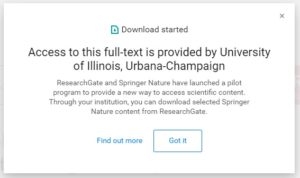The leakage of scholarly content through a variety of mechanisms, some perfectly legitimate and others proud pirates, is the major factor driving down the value of subscriptions and enabling major library and university groups to cancel their Big Deals. ResearchGate has by far the largest traffic of any of these sites of leakage and has built a growing bundle of services for those seeking access to scholarly content. Some publishers have responded with lawsuits, while others see an opportunity to leverage this leakage and stabilize the academic library sales channel.
Today it is clear that Springer Nature is leading in the effort to preserve library subscriptions by syndicating its content and, in doing so, would establish ResearchGate as perhaps the foremost service for the distribution of scholarly content.

Syndication is Developing Rapidly
Syndication enables users to access subscription content based on the publisher-library license agreement on well-trafficked platform sites, beyond just the publisher website. Syndication thereby turns leakage into COUNTER-trackable usage, diverts leakage back into the library channel, and accretes value to the Big Deal.
Syndication is a fundamentally different model for enabling access to content than aggregation. In the aggregation model, publishers license their content to an aggregator (such as ProQuest or EBSCO), which in turn licenses the aggregation to a library and then the library provides access to the aggregation. In syndication, the publisher distributes content to other platforms for user access that is dependent on direct publisher-library license agreement but the library is not a party to the syndication agreement. Syndication centers distribution more around users than around publishers or libraries. This is a major difference in both business model and in policy control.
Syndication requires several elements — distribution rights, usage logging, and entitlements:
- Distribution Rights. Syndication requires that the publisher has the rights to distribute or allow the distribution of content beyond their own site. This may be a non-issue when a publisher owns a journal directly but it could add meaningful complexity in cases in which they publish on behalf of scholarly societies.
- Usage Logging. Syndication requires distributed usage logging, which allows usage via a third party service like ResearchGate to be counted by the publisher in reporting usage to libraries, authors, and societies. Distributed usage logging was recently launched by Crossref, COUNTER, and major publisher organizations.
- Entitlements. Syndication also requires some mechanism for establishing which users are entitled to access what content on the third party platform. Major publishers have yet to agree on a standard for sharing entitlements, apparently the result of the strategic differences among them on syndication, so the approaches being developed in the Springer Nature pilot, which we discuss below, are of special interest as possibly accreting into a de facto standard.
There have been ample signs signaling the development of syndication as a way to divert leakage back into legitimate library sales channels. It has been clear for some time that poor user experience is a major factor driving leakage, perhaps on par with piracy.
The STM Association decided on RA21 as its solution, imagining that it could address the piracy challenge under the guise of improved user experience for library subscriptions, but doing little to address the most important source of leakage while also unfortunately introducing powerful new privacy dilemmas along the way.
In addition, publishers have been looking for alternative distribution mechanisms for their content. After distributed usage logging was announced last fall, the CEOs of both Springer Nature and Wiley commented publicly in Frankfurt that their houses were working on a shared entitlements system, which could enable syndication. Earlier this year, the University of California followed Germany and terminated its negotiations with Elsevier, leading to the cancellation of their content license and the inevitable conclusion that leakage is destroying the value of the Big Deal. Given these developments, among others, no one should be surprised to see the emergence of this bold new model for content distribution — syndication.
Likewise, we’ve known for some time that, while some publishers take a highly contentious stance towards ResearchGate, others have taken a different approach. Whatever one might have thought about ResearchGate earlier in its development, it has clearly arrived as a major service for researchers. ResearchGate is one of the most trafficked science websites globally and has more than twice the traffic of Google Scholar and many more times that of Sci-Hub. ResearchGate is also without question a site of leakage and that is precisely what also makes it an attractive platform for syndication.
Perhaps in part because of ResearchGate’s involvement, a number of colleagues have been dubious. Kent Anderson called syndication “Snoozeville” and emphasized “The more I think about it, the less I see here.” David Crotty articulated some of the deepest publisher concerns about syndicating content, noting:
Essentially you’re asking for publishers to turn their business over to a competitor, to give up all advertising revenue and any connection to or data about their users, and morph into the sales wing of a bigger publisher/platform owner. You’d lose all your branding, and as noted above, you’d essentially be locking yourself into being a part of someone else’s product, with the continual reduction in value of your offerings that creates.
But, while there is little news in businesses resisting change that may prove disruptive to them, not all publishers are identically situated or strategically oriented. Springer Nature has comparatively more open access exposure than other major publishers and a recently failed IPO, two factors that position it differently than some of its peers. And so earlier this year (on the same day that California canceled Elsevier), Springer Nature announced its pilot to syndicate selected content to ResearchGate.
Syndication Pilot Matures
With last week’s announcement that Springer Nature is entering the next phase of its partnership with ResearchGate, we can see the continued development of this collaboration as a case of syndication. Returning to the required elements of syndication — distribution rights, usage logging, and entitlements — all three elements are now in place as Springer Nature’s pilot syndication to ResearchGate matures.
The first iteration of the pilot began in March when Springer Nature uploaded 6,000 articles published in 23 Nature research journals to relevant author profiles on ResearchGate. Though Springer Nature declined to comment on usage statistics, response to the pilot was reported to be very positive. Based on a survey of more than 700 ResearchGate users, 90% reported a positive or very positive reaction to Springer Nature and ResearchGate working together and 96% reported being comfortable or very comfortable with their Nature full-texts being automatically added to their articles on ResearchGate.
Anecdotes of appreciation were also posted to Twitter:
This was a nice surprise! Thanks, @SpringerNature for making our @NatureEcoEvo study available for the scientific community on @ResearchGate! #fishsci @LeibnizIGB https://www.researchgate.net/publication/327404073_Individual-_and_population-level_drivers_of_consistent_foraging_success_across_environments
It was striking that the first iteration of the syndication pilot did not have any access controls based on entitlements. Though the articles that were uploaded were not published open access, the pilot had the effect of making them openly available on ResearchGate. It was clear from the beginning, however, that this was an early experiment rather than a decision to avoid access controls altogether.
The second iteration of the pilot that started last week addressed this final element of syndication by introducing access controls.
For those who have a library entitlement via a Springer Nature institutional subscription, they will have access to a downloadable format on ResearchGate, just as they would from the publisher website accessed through a library subscription. When a user is provided access because of the investment made by their institution, this is communicated to them on the ResearchGate platform.

Unfortunately, the messaging does not indicate that this access is provided via the library subscription, nor does it direct users to their librarians if they have any questions or need assistance.
ResearchGate users without entitlements via a Springer Nature institutional subscription will continue to have access to articles in a non-downloadable format. It is worth noting that this is the version of record, which diverges from Elsevier’s tactic of providing an author manuscript to the non-entitled, and so all users (entitled and non-entitled) have access to the version of record.
The project partners (ResearchGate and Springer Nature) have indicated that they are not able to go into further detail as to how the entitlements are being verified at this time. Nevertheless, with Lisa being affiliated with a university with Springer Nature subscriptions and Roger not, we were able to explore the user experience of this pilot on ResearchGate rather extensively.
Most notably, authorization does not require that the user login through a proxy server, access broker (such as Kopernio), Shibboleth, or another SAML or RA21 system, but rather relies on some other mechanism. The code behind the rendered web pages did not seem to show that the entitlements information was being passed from Springer Nature, but rather that ResearchGate is determining authorization using a database it accesses directly or perhaps via API.
ResearchGate recognized Lisa as an Illinois-entitled user from off-campus, with cookies cleared, and using a ResearchGate account that is currently connected to a Gmail email address though originally created with an illinois.edu email address. Lisa’s profile lists Illinois as her current employer. When Roger had Ithaka S+R listed as his employer in his ResearchGate account, he was only able to have non-entitled access — except when he was using the guest wifi at a local university. So, it seems that IP address ranges are one part of the authorization approach being used. Even then, however, the messaging on ResearchGate said the access was provided by Springer Nature rather than the university.
We documented that by changing our asserted institutional affiliations, e.g., to our undergraduate institutions or to those with which we have had no affiliation ever, ResearchGate would provide entitled access to us. In these cases, ResearchGate indicates that access was being provided by those institutions. In other words, the current entitlements approach uses self-asserted institutional affiliations.
From this exploration we are tentatively inferring that entitlements are determined by ResearchGate using Springer Nature institutional subscription information matrixed with the user’s asserted institutional affiliation and possibly general IP address range.
We also noted that the PDFs one downloads from ResearchGate are different files than the PDFs that are downloaded from the Springer Nature platform. Both platforms provide the version of record PDF but the files from ResearchGate had different watermarks in the footer than those from the Springer Nature platform. This makes even clearer that this is truly a case of syndication to the ResearchGate platform and not linking out from ResearchGate to the publisher platform, such as is done from library discovery layers.
Though further refinements are needed to provide a fully robust entitlements system (for example, to accommodate scholars with more than one institutional affiliation and thus multiple library entitlements) and it is not clear if the usage data is yet flowing into library COUNTER reports via distributed usage logging, the Springer Nature project with ResearchGate has matured to encompasses all three elements of syndication in a few short months.
The Tension for Libraries
According to Steven Inchcoombe, Chief Publishing Officer at Springer Nature, syndication is a service for libraries as well as users: “We do consider our pilot collaboration with ResearchGate not only as a huge service to researchers but also to our library partners as it provides their users with much more seamless access both on and off campus, even when they are on a third party platform such as ResearchGate.”
Indeed, in many ways, the Springer Nature syndication to ResearchGate is a fulfillment of the vision of getting libraries “in the flow” — that “the library needs to be in the user environment and not expect the user to find their way to the library environment.” ResearchGate is a well-established platform for researcher workflow and its proactive outreach strategies, metrics and analytics reports, and social networking features all work to further solidify scholar reliance on the platform. Bringing library-subscribed resources into the scholar’s workflow on ResearchGate helps to ensure that scholars have easy and seamless access to licensed materials and bypasses the cumbersome process of moving from a citation on ResearchGate, back to the library website, only to then be required to navigate the link resolver, authentication mechanisms, and the publisher platform before getting the PDF. With syndication, discovery is delivery.
Being “in the flow” through syndication does, however, create tension for libraries. Libraries are currently benefiting from an improved negotiating position with leakage carving value out of the Big Deal and subscriptions generally. Moreover, libraries are publicly encouraging their users to capitalize on leakage in cases of cancellation. For example, UC Berkeley’s guide to alternative access for Elsevier articles recommends three strategies that leverage leakage: find copies online through browser plug-ins (e.g., the OA Button), check online repositories (e.g., SSRN), and request articles directly from authors (e.g., via ResearchGate).
Librarians may wish to note that, while there is no formal mechanism for libraries to opt out of this Springer Nature/ResearchGate syndication pilot, they can get in touch with their Springer Nature representative if they have feedback or questions. Libraries may also want to consider this checklist of actions in light of the continued development of syndication.
Looking Ahead
This pilot project between a major publisher and what is arguably the largest source of leakage leads us to believe that the comments in Frankfurt portend coming growth in syndication. We have every reason to believe that this development is in the best interests of users, who will begin to encounter the version of record “in the flow” of their research and scholarly collaborations on an increasingly frequent basis. As noted above, others remain skeptical or antagonistic to syndication and it seems that there is little library response so far.
As we expect to see syndication continue to progress, we look forward to tracking further developments with a number of key questions in mind:
- What, if anything, could cause the current agreement, still characterized as a pilot, to slow or to be abandoned?
- How might a full production model of syndication be different from the pilot beyond increased scale?
- Will libraries accept, or even embrace, syndication or will they resist? Might they seek to regulate it through negotiated license terms or perhaps try to limit it?
- How will users react to a differentiated ResearchGate experience based on whether they are entitled or non-entitled to a downloadable PDF via a library subscription?
- Will ResearchGate continue to rely on advertising and analytics as its business model for content distribution or, under a syndication model, will it be able to identify other sources of revenue?
- What privacy concerns are raised by syndication, particularly with regard to third-party platform tracking, and to what extent might those be addressed?
- Will other publishers join in on this syndication pilot with ResearchGate or develop competing syndication models with other platforms? If not, will Springer Nature see a competitive advantage on a one-publisher basis or will a lack of greater engagement from the publisher community cause syndication to stall out?
- And, what platforms beyond ResearchGate, if any, might take on the role of distributor platform under this syndication model? What business models might they utilize and will they be sustainable?
As an emerging model, the ultimate question is whether syndication is strategically astute or only a distraction from long-term trends. Continuing to monitor these developments is thus of the greatest strategic importance for scholarly publishers and academic libraries.
Discussion
15 Thoughts on "Diverting Leakage to the Library Subscription Channel"
A refreshing look at progress that evolves from making it faster, easier to access licensed content than it is to use unlicensed alternatives. Step by step, one step at a time.
It’s unclear to me why making more of your content freely available through non-subscription channels will result in increased subscriptions. If one is guaranteed access to a copy of every Nature paper (even if a non-downloadable version), then how does that help Springer Nature maintain its subscription business model? Doesn’t knowing that your patrons have access to 100% of Nature’s papers give the library more leverage and motivation to stop paying for Nature subscriptions? Wouldn’t seeing a COUNTER report showing the majority of your users getting their content from ResearchGate make a librarian question the need for continuing to pay Springer Nature for that same free content?
I also think it’s a bit disingenuous to ping RA21 for “privacy dilemmas” while touting the use of a privately-owned business that is based entirely on advertising and spying on users (and potentially selling off their data to anyone willing to pay). To their credit, RA21 has reached out to stakeholders across the community and has worked to address their complaints (and is still seeking additional participation from the library community). As far as I know, ResearchGate has never disclosed what data they collect on users and what tracking they do, nor have they shown any willingness to work directly with the community to alleviate any such concerns.
The obvious big question here is whether syndication like this is actually a viable business. ResearchGate has a huge level of traffic yet cannot make enough money from that traffic to break even, let alone turn a profit. This smacks of the standard internet model, of driving traffic and engagement while losing scads of money, and then selling the company off to someone else and letting the business model be their concern. You could see this being a feature offered by a larger company (https://scholarlykitchen.sspnet.org/2015/01/27/when-is-a-feature-a-product-and-a-product-a-business/) but any purchaser must be a neutral third party – if it ends up being owned by a publisher, then it will be seen as a direct competitor and cooperation (and syndication of articles) from other publishers seems unlikely.
I expect that, now that the library is implicated in what ResearchGate data has, we’ll see a dialogue about the privacy issues here. Unlike RA21, which has always been able the library entitlements, until now ResearchGate was not. Though, for what it is worth, librarians have been raising the concerns about tracking on ResearchGate for a long time. In fact, I’m pretty sure at least one person told me that’s why I shouldn’t worry about RA21 – ResearchGate already does it.
As we pointed out here today and Roger did in “Isn’t Leakage Good for Libraries?” – there are many reasons libraries should be discussing this … strategic, operational, tactical.
Is there any indication that ResearchGate is willing in any way to be open about the data they’re collecting and open to changing their practices? I’ve not seen any, and doing so would seem in direct conflict with their business model. It’s a bit like expecting Facebook to be transparent on what data they collect.
ResearchGate is 10 years old and about time to be sold. While it is not in a break even position it is still an attractive property for someone but not necessary a publisher. My network hasn’t picked up anything about the company being shopped around. Most companies go through a lipstick phase, where the company is groomed to sell. The parts are all there, except a revenue stream, but are investors getting tired of writing checks to cover the loses? I believe that some company will add ResearchGate to their portfolio. The only question is when? Syndication may be the feature that gets some business development department’s attention.
It’s worth considering the level of investment that’s gone into ResearchGate (https://www.crunchbase.com/organization/researchgate#section-overview), and what price would be required by investors to get significant return on their investment. That then sets a pretty high price for a non-profitable service with no clear business model.
Certainly $87m is a lot of money but often it is pension money that is pooled and investors may never seen a full return but in time something is better than nothing. I am glad I don’t have any clients that have invested. Someone has sold the upside potential. Maybe one of the Chinese companies will consider buying.
They have some pretty high level investors:
https://www.researchinformation.info/news/researchgate-announces-52m-investment
“ResearchGate, the professional network for scientists, has announced investments from Wellcome Trust, Goldman Sachs Investment Partners, and Four Rivers Group with participation from Ashton Kutcher, Groupe Arnault, Xavier Niel, and existing investors Bill Gates, Tenaya Capital, Benchmark, and Founders Fund. ”
If they’re looking for a good return, then the price will likely be too high for most buyers. Of course that’s assuming the company will retain its value after the current lawsuit concludes and the new EU Copyright Directive goes into effect. Both of those are likely driving factors in this pivot.
What happens when users realize that changing their institutional affiliation (to, say, Harvard or Hopkins or Stanford) will let them download more articles? Will community standards of honesty stop this from inflating COUNTER stats for R1 libraries? Is Springer Nature already working on a way to verify your institution? ORCID might be useful here.
Robin, when you say “changing their institutional affiliation,” do you mean changing jobs (i.e. changing their actual affiliation), or are you suggesting that users might misrepresent their affiliations?
Rick, I meant that some RG members might fraudulently claim an affiliation, just to get access to the articles. As Lisa and Roger describe above.
Really? Suggesting Syndication? (RSS)…This post gave me a 20 year flashback to the time I was at Cell Press, before Elsevier bought it. Keith Wollman and I were debating about whether to add this thing called an RSS feed to the HighWire-hosted version of Cell.com. It was new and cutting-edge and he was for it. I was against it. As a marketer, I was trying to build our email TOC subscriber list since that was the main channel for generating website usage (usage went up when TOC emails went out). We were starting to sell eTOC sponsorships so there was revenue at stake too. Fortunately Keith won that argument (he was almost always right) and RSS allowed Cell – and nearly all journals that later added that feature – to generate new readership without relying on a linear push approach. The take away then still applies today: If you want your content to be read as widely as possible, put the content where the readers are and don’t try to force readers to your content.
Great post Lisa and Roger. And cheers to Springer Nature for prioritizing service for authors – who after all want their articles to be read as much as possible, whether it’s at nature.com or Research Gate or PubMed Central or their institutional repository or wherever. And the good folks at PLOS are thinking “our content has ALWAYS been available for posting on other sites like Research Gate” so cheers to them too. This is after all the advantage of Open Access that people have been talking about for years.
Mark, all this has nothing to do with syndication as in RSS, unless you consider it a way to send notifications about new articles to ResearchGate users. I’m not sure why the authors picked this fight on the syndication vs. aggregation vs. whatever terminology, but what’s happening is very simple: a copyright license from the publisher to ResearchGate.
SSRN did it with Wiley many years ago, Elsevier has been doing it for years with Mendeley and SSRN. The only difference is that ResearchGate is bigger and that someone was convinced that all publishers ought to follow Elsevier’s whip and consider it a pariah.
Hey Federico – I used RSS as a metaphor that happens to include “syndication” in its name. RSS was a new way to generate readership 20 years ago. Some publishers feared it back then because it was new and potentially disruptive. But ultimately it was a net positive for both publishers and readers. 20 years later publishers fear the syndication approach that Springer Nature is taking with Research Gate because it is new and potentially disruptive. I think ultimately this approach will be a net positive for authors and readers and therefore also a positive for the publishers who embrace it. And the very simple copyright license from publisher to Research Gate is not really so new, as you point out in the examples you provide. The CCBY licensing of OA journals, approaching 20 years of existence, allow Research Gate, blogs, Twitter, and other so-called sources of leakage to spread an author’s work in a legal copyright-compliant way. It’s only “leakage” if you try to control access via your own platform; it’s actually really smart marketing to allow your content to live on as many platforms as readers demand.



